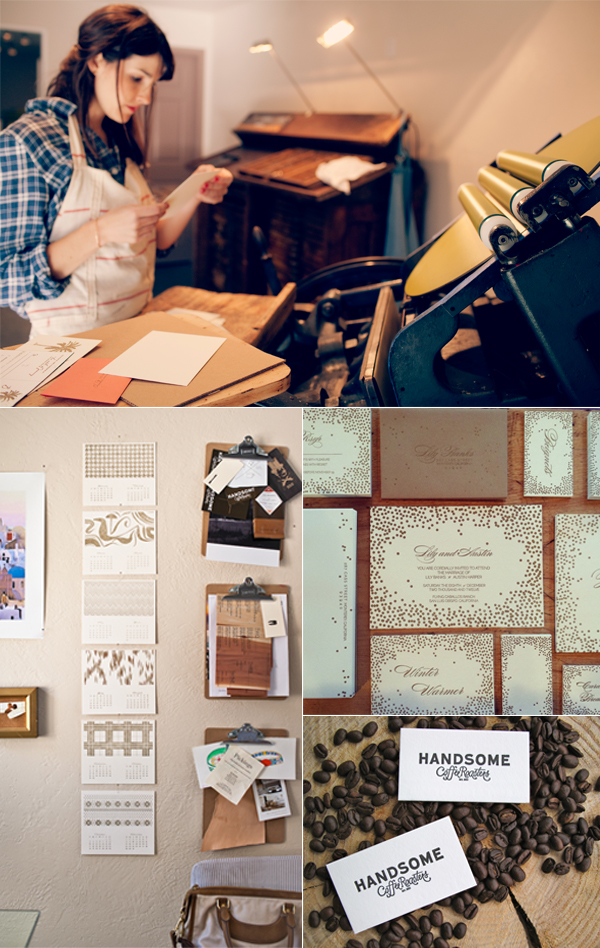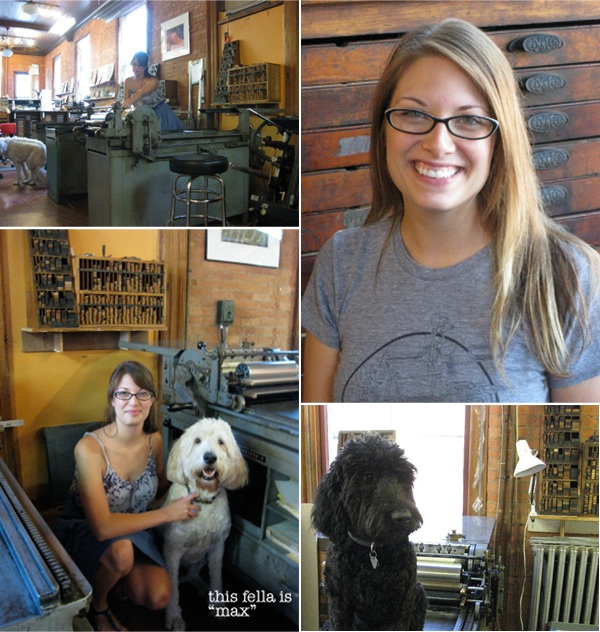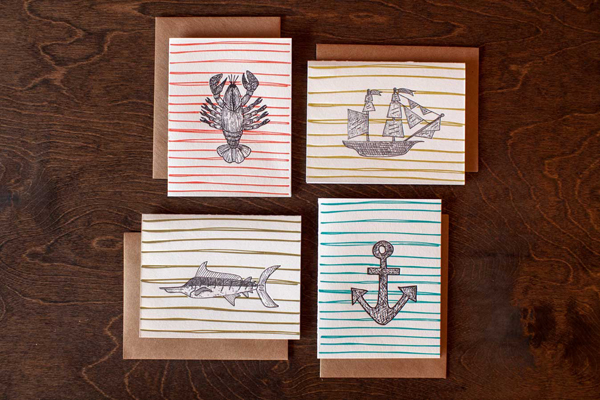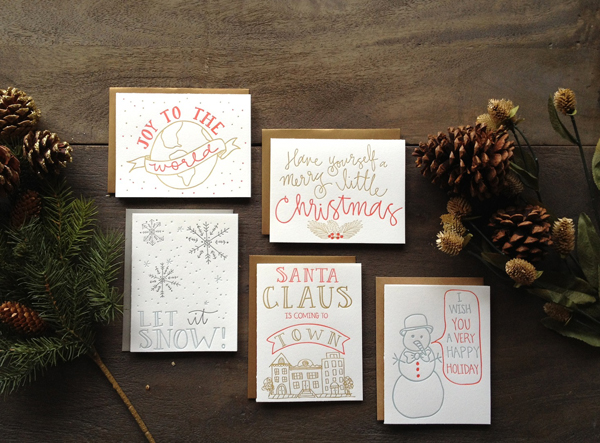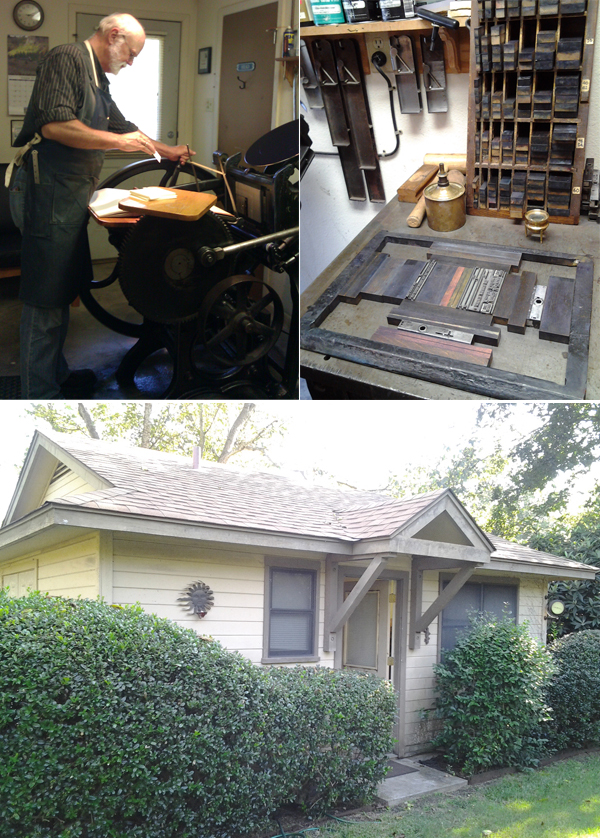There’s a vibrancy when Annika Buxman of De Milo Design Studio & Letterpress speaks about braiding her foci of letterpress, responsible printing, faraway homelands, and her support of Fair Trade paper. Deftly she passes from one story to another, entrancing us, while her C&P mirrors her movements. Paper to ink. Printed piece to hand. Annika paused the press so we could ease in a few curious questions into the extraordinary printing tapestry around us.

THE CREATIVE CASE OF ANNIKA BUXMAN Machinery is in my blood. I mostly grew up in Bakersfield, California in the 1970’s. At that time the landscape, even in town, was covered with functioning oil wells. The “head” on a long “neck” was constantly moving up and down like a gargantuan horse leaning down to drink. I named dozens of them and felt a special kinship with these “creatures”. The oil wells combined with the farm equipment in my grandparents’ barn made me feel at home with wrought iron and rust. I didn’t learn how to use a computer until college in 1988, so mechanical rather than digital functionality is imprinted in my brain. A completely different childhood experience from Bakersfield was being born in Africa (Kinchasa, Zaire) and having those images and stories around the house. My family also lived in Manila, The Philippines, right after the revolution in 1987 and traveled around that part of the world for a year. Those experiences gave me a strong sense of poverty in developing countries. But it seemed like too big of a problem to solve. When I learned about how small businesses can make a difference through the practice of fair trade it was the perfect fit for De Milo Design.
Locally, I enjoy teaching the art of letterpress to people in my studio and working on custom invitations, business cards and personal stationery. Globally, I’m committed to promoting cross cultural business relationships with women in developing countries through the development and sale of their handmade paper via my fair trade and eco paper line “Sustain & Heal.”
LOVE AT FIRST SIGHT I first saw letterpress printing in the gallery at Art Center College of Design where I was a student in 1993 and was fascinated. I took their Archetype Press class. I thought it was just a fun elective. I never thought I would do it for a living so I didn’t pay very close attention. When I started up my shop I had to go back and take the class again.
STAYING COOL IN CALIFORNIA South Pasadena, California is a small town about 10 miles northeast of downtown LA. The entertainment industry does a lot of filming here when they need the “quaint-cute-midwestern-small-town” look. The front of my street level studio has huge windows that look out onto the main boutique shopping and gallery section of town. The Goldline light rail station and weekly farmers market is just down the street and the chamber of commerce organizes art walks 4 times a year so there’s a lot of foot traffic. I treadle my C&P in front of the windows every chance I get. Working the press with the backdrop of lovely marbled fair trade papers always attracts attention.

PRINTING MENTORS My first printing mentor was Regis Graden. I met him just in time because he died a few years later. But in those few years my skills improved by leaps and bounds largely due to his input. When I called him with a question often he would say “I could tell you but it would be easier to show you. I’ll be there in 20 minutes.” Here is a bit more about him on my blog. Today my mentors are other printers like me who are each doing their own thing with letterpress. Close to my studio there are at least a dozen printers — Maude Press, Lala Press, Anenome Press, Fugu Fugu Press, and Papermum Press, just to name a few. And we all rely on local printing legend Gerald Lange. The International Printing Museum puts on an annual printers fair and it’s fun getting together with other local printers to talk shop and exchange advice. The Ladies of Letterpress conference this past August provided me with a host of contacts and I love their discussion board.
THE CREATIVE PROCESS The unexpected juxtaposition of materials is the most fun way for me to design. At Art Center I learned the basics of a good layout (first, second, third read, and dynamic “white” space) and picked up an appreciation for meticulous typography. Applying those skills to combining different materials is my favorite way to design. Most of my work ends up being a collage of some sort. I could get a PhD in adhesives!
FULL TIME FUN I am both a designer and printer, and I’ve been printing full time since 1998.
PRESS HISTORY I bought a 8×12 C&P Old Style Treadle Press from the International Printing Museum in Carson and drove it to Pasadena on Los Angeles freeways on a little trailer that was only rated to carry 500 pounds. Dumb.

PRINTING FEATS In 2007 I designed and launched a line of fair trade and eco friendly papers called “Sustain & Heal.” It primarily features handmade & handmarbled papers and a specially made for letterpress Jute sheet. Later I traveled to Bangladesh to meet with many of the artisans who make the paper and see what a huge difference it makes in people’s lives when we buy fair trade. Taking “Sustain & Heal” to the National Stationery Show and bringing the message of fair trade to people there for the last six years has been a huge undertaking. I’m terrible at marketing and showing my work. I dread public speaking and talking to strangers, especially when they stare at me blankly after my passionate little speech about fair trade. Doing this show has been an area of personal growth and I’m proud that I rise to the challenge year after year.
BOXCAR’S ROLE When I first launched my website in 1999 there were not many other letterpress websites out there. Boxcar made me feel like I wasn’t alone, or crazy, to be doing what I was doing. They also gave me a laugh with the “What is Harold wearing” section. They continue to be ahead of the curve and leaders in this industry. Their habit of eco-friendly practices inspire me to do the same.
PRINTING ADVICE Regis [Graden], my first letterpress mentor, used to say “You know the only sure way to not make a mistake? Don’t ever do anything!” He also once consoled me when I called him with my latest printing woe, “You made a mistake? I can’t believe it. The last time I made a mistake was…let me think…ten o’clock this morning.”
WHAT’S NEXT So many “high on talent, low on bank account” folks walk into my studio each week with their wonderful designs that they want printed. Often they leave disappointed because they had no idea letterpress requires so much effort and is on the higher end of the price scale. So I’ve set up a “letterpress lab” program for people to come into the studio and print their own designs for a small equipment rental fee. So far it’s worked well with the few people who have tried it. I’m looking forward to expanding this program next year.
Again, a big round of thanks out to Annika for letting us catch a glimpse of the spectacular work of De Milo Design Studio & Letterpress!
